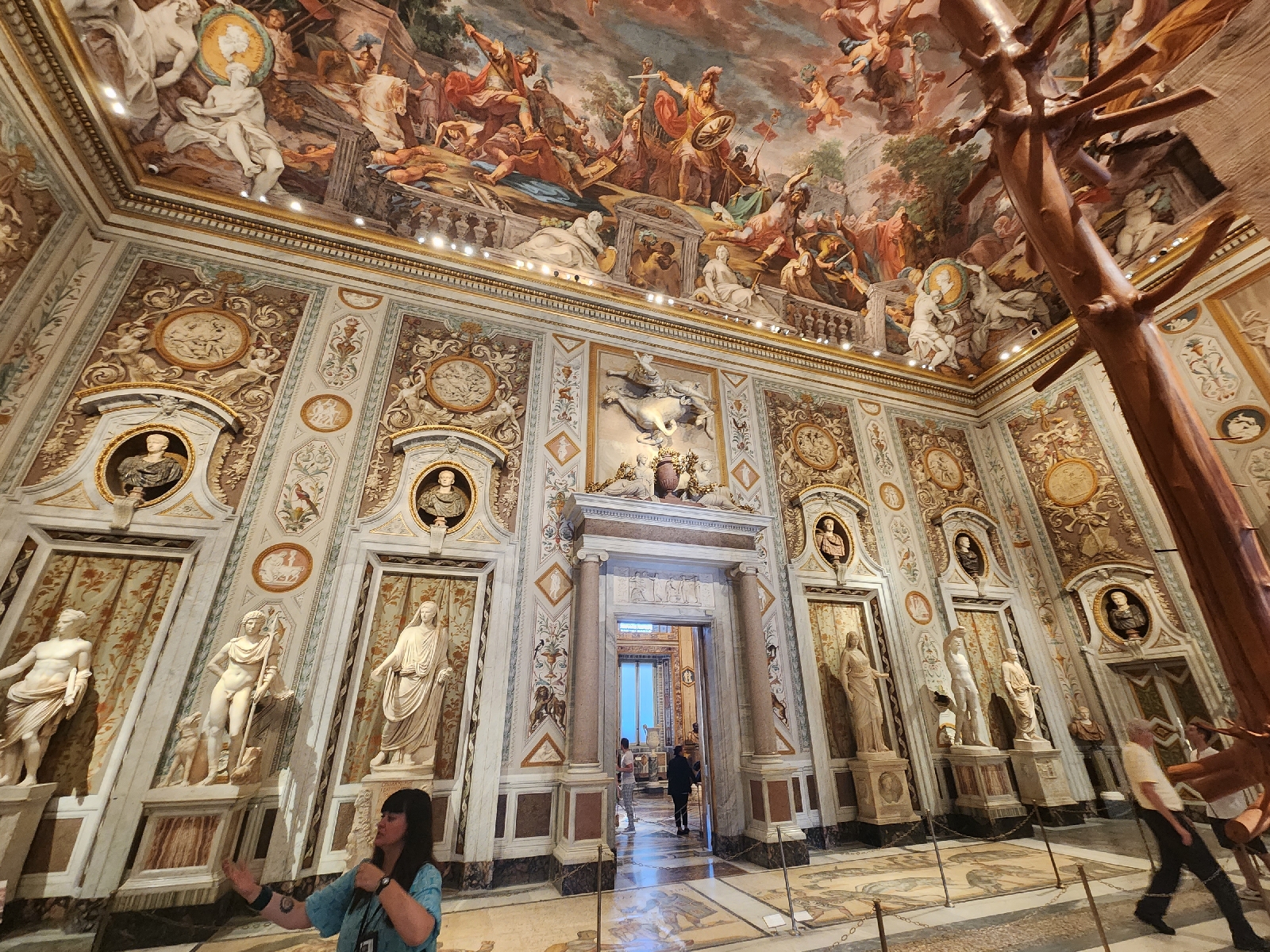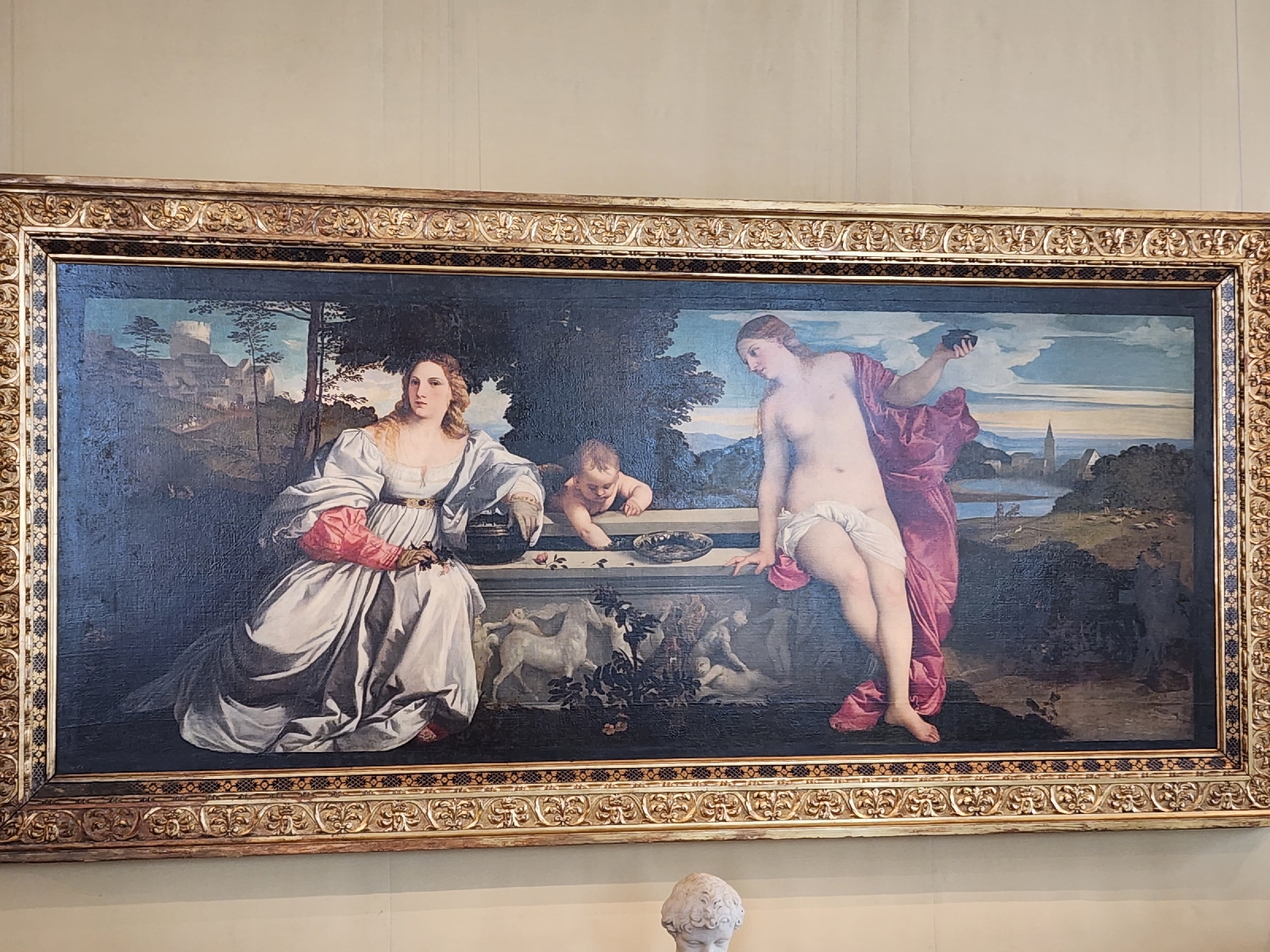Pluto and Proserpina
The genius of Bernini was immediately known in the way he could make sculptures alive. His method was to depict figures “in action”, at just the moment of the highest tension prior to resolution. This sculpture of the god Pluto carrying away Proserpina was completed early in his career. It captures the moment at which Pluto crosses the border of the underworld with the captive Proserpina.
A gorgeous work of sculpture, it was revolutionary in several respects. It active, not passive and/or stoic. This sensation is heightened by the life-like depiction of surfaces: the skin around Pluto’s eye is affected by Persephone’s struggle and Pluto’s fingers press into Proserpina’s thigh. Proserpina has shed a tear, the first tear ever to be depicted in sculpture. And Pluto, a god, is not perfect: a small mole marks a spot on his back.
Apollo and Daphne
Another exquisite sculpture, in this work, Bernini chose to depict the doomed love of Apollo for the nymph Daphne. As she flees Apollo’s chase, Daphne’s father, the river god Peneus, turns her into a tree. Bernini captures the complete motion of her transformation. Starting from one point at this work, Daphne’s transformation has only just begun, and Apollo appears to be one step from catching her. As you move around this work, Daphne’s transformation into a tree is completed and Apollo’s failure is evident.
David
Bernini knew that he would eventually need to take on this subject but was daunted as other famous sculptors had already made their fame with it (i.e., Michaelangelo). In his style, Bernini chose a new moment: the moment immediately prior to David’s loosing the stone that fells Goliath. Another action scene, although Goliath is not visible, David’s gaze and pose allude to his opponent’s size.
Bernini always used the cheapest marble. In this way he could make the biggest profit. As a result, the block he obtained for this work was not large enough to complete the piece – the heel of David’s left foot was plastered on after the work had already been accepted by the Cardinal.
Truth
Was a work Bernini created for himself and kept it in his workroom. In this way, Bernini was able to remind himself that he had talent. Truth, portrayed as a woman, sits between the sun (in her hand) and the earth (at her foot), also reminding Bernini that truth is found in time.
The second floor is dedicated primarily to Italian painting.
Raphael – “The Deposition” (oil on wood)
Commissioned by a family in memory of their dead son, this painting was revolutionary because of the way Raphael creates a sense of motion in the painting, by using the same face on different people to make it seem as though the face is moving. Raphael’s colours were always the most vibrant. The use of light is also particularly careful. The semi-shadow created by the body of Christ is cast on the figures of those surrounding his body, while the sun shines brightly on those places unaffected.
Titian - "Sacred and Profane Love" (oil)
This painting depicts two women at a pool who are in fact the same woman. On the left, a sober looking woman dressed in rich brideclothes. She is gathering flowers, two rabbits (symbolizing fertility) run in the background, in front of a castle (symbolizing the maintenance of a household). The time of day is the dawn. On the right, an almost nude woman in a red garment leans casually on the poolside at sunset. In the middle, Cupid stirs the waters of the pool.
Caravaggio
Caravaggio was Scipione’s favourite artist. Though the gallery now houses the largest collection of Caravaggio, Caravaggio would never consent to meet with the cardinal. Rebellious and disdainful of authority, Caravaggio wanted nothing to do with him. Still, Scipione acquired his works whenever he could.
Caravaggio came to Rome at 25 years of age and immediately made a big name for himself. His hot temper ended in the murder of a Roman and landed him on the run from Roman authorities. Moving between Naples, Sicily, and Malta, another murder on the way and just ahead of the authorities, Caravaggio died at age 38.
The Stains
As breathtaking as these artworks are to admire, the superlative quality of the art is matched by the deviousness of Cardinal Scipione himself.
The cardinal stole many works of ancient art from around Rome, whether just lying around, part of other buildings, or private residences.
Raphael’s Deposition, commissioned by Perugia for the altar of the cathedral, was stolen by hired thieves from the Baglioni family chapel in San Francesco al Prato, Perugia. The theft caused the town of Perugia to riot. The family and town were placated with a copy, at the direction of the pope.
Scipione threw Domenichino into prison to convince him to hand over “The Hunting of Diana”. The painting had been commission by Cardinal Aldobrandini, who subsequently handed over the painting and paid to have Domenichino released from prison.
Caravaggio’s “Madonna of the Serpent” was commission by the Papal Grooms. Scipione had it taken down under Papal Decree for “excessive realism”, then purchased the painting at half price.
Scipione confiscated 197 works by the famous painter Cavalier D’Arpino, Caravaggio’s teacher.
While on the run, Caravaggio conceived of a plan to plead with the Cardinal to arrange his pardon. Caravaggio painted the beautiful works of “David with the Head of Goliath” and “St. John the Baptist”, planning to present them to the cardinal on entering Rome. Carvaggio loaded the paintings on a ship in Naples for sail to Rome. The Cardinal’s thieves stole the paintings before the night before the ship sailed, ignoring subsequent communications from Caravaggio, who later attempted to walk from Naples to Rome to plead with the cardinal, dying on that journey.
To see a beautiful Caravaggios which have escaped the grasp of Cardinal Borghese, see the painting of St. Francis in meditation at the Capuchin Crypt Museum, the Pilgrims’ Madonna at the Basilica di S. Agostino, and the paintings of St. Peter and St. Paul in the Basilica of S. Maria del Popolo.
As wonderful as it is to have such a rich heritage preserved for the public in one location, it is gratifying that not all of any one artist’s work is confined to the Borghese.
The villa and grounds were purchased by the Italian state in 1901, ensuring future public access to these national treasures.
Shawn Bausch














Comments
Post a Comment